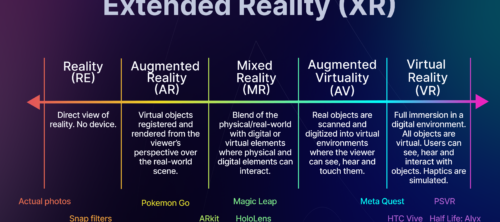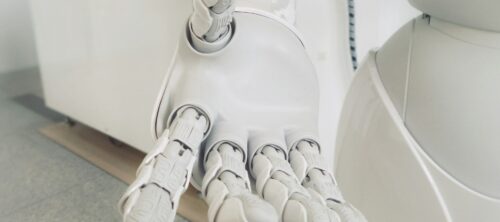
Creating 3D models: A deep dive into traditional and AI-generated 3D modeling methods
In the space of 3D modeling, a revolutionary shift is taking place. Traditional methods, while still prevalent, are being challenged by the rise of artificial intelligence (AI). AI-generated 3D modeling, while still majorly in it’s infancy phase with many AI tools for 3D content generation in beta or accessible for experts, is starting to transform the way we create and interact with 3D digital assets. This technology, which includes text-to-3D, image-to-3D, and video-to-3D methods, is not only faster and more cost-effective, but also opens up 3D modeling to those without extensive technical expertise.
In this article, we will delve into the world of 3D modeling, looking at some popular traditional methods, exploring their applications, pros and cons, and examining how AI is shaping the future of 3D content creation.
Let’s dig in.
What is 3D modeling?
3D modeling is the process of creating an interactable digital model of any object or surface, either real-life representation or abstract, within a three-dimensional (3D) space using specialized 3D rendering software.
What are 3D models used for?
3D models serve a multitude of purposes across various fields. In the entertainment industry, they bring life to characters, environments, and props in films and video games.
Industrial designers utilize them to visualize and prototype products, while architects and engineers employ them to plan structures and identify potential construction issues.
The medical field uses 3D models for detailed visualization of biological processes, aiding both research and patient education.
In the realm of education, they help students grasp complex concepts, and in marketing, they create engaging product visuals.
3D models are also becoming increasingly popular in e-commerce to enable virtual-try on (VTO) for wearables.
Additionally, the immersive environments of Virtual Reality (VR) and Augmented Reality (AR) are all built on 3D models, and in the world of 3D printing, they form the blueprint for physical objects.
☝️ If you’d like to learn more, wrote an article about how 3D is used across different industries in 2023.
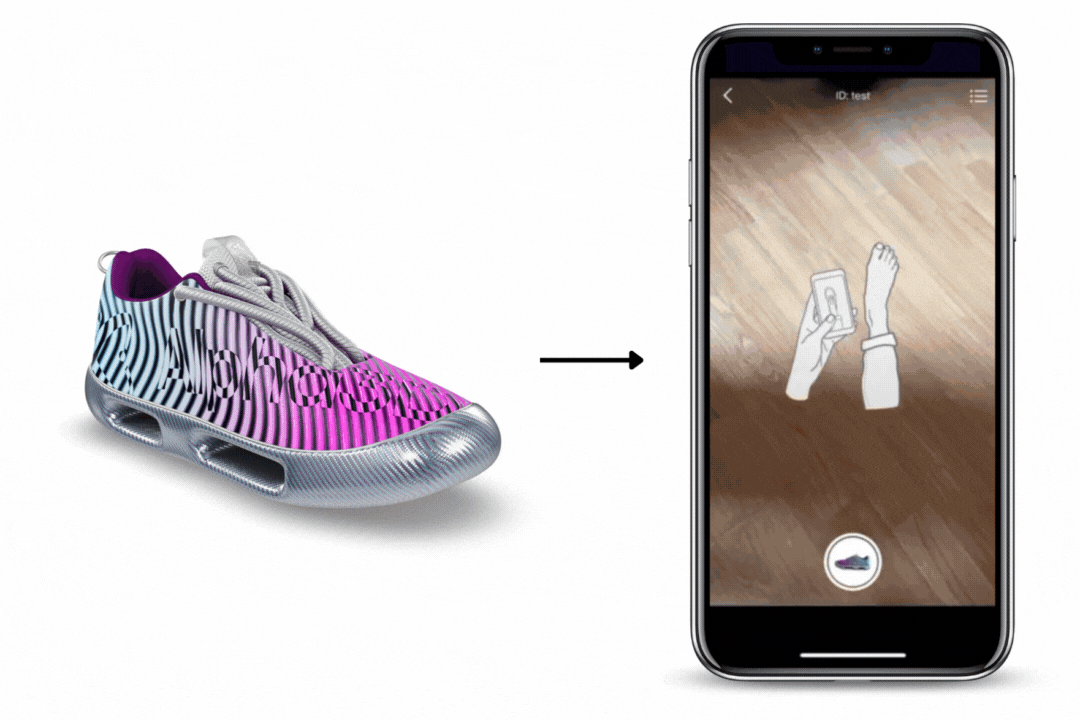
What are the traditional methods of creating 3D models?
Box Modeling
This is a basic technique where the 3D artist starts with a primitive (like a cube) and then refines its shape by subdividing the surface and manipulating vertices, edges, and faces.
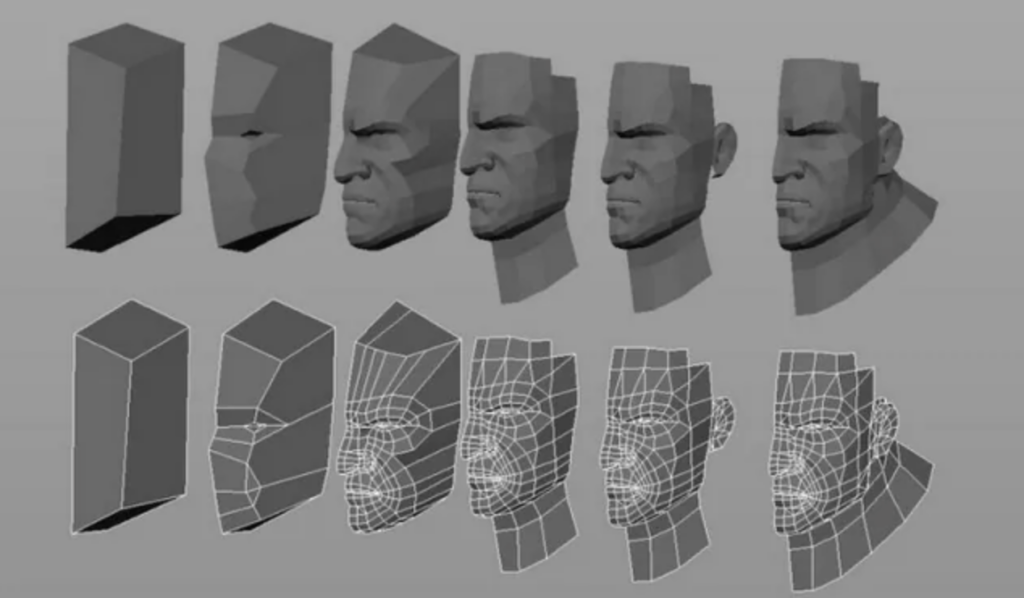
(Image from Information Transformation Services)
⭐️ Where and for which use cases is Box Modeling used?
Industries: Video games, animation, product design.
Use cases: Creating characters, props, and environment elements for games and animations.
Model types: Characters, props, environment elements, basic product models.
👍 Pros of using Box Modeling:
Intuitive for beginners, good for creating basic shapes and structures, widely supported by 3D software.
👎 Cons of using Box Modeling:
Can be time-consuming for complex models, requires good understanding of topology for best results.
🧰 Some of the popular tools used for Box Modeling:
Polygonal Modeling
In this method, the artist constructs the 3D model by specifying and connecting its constituent pieces (polygons). It’s a bit like creating a paper model, but in a digital space.
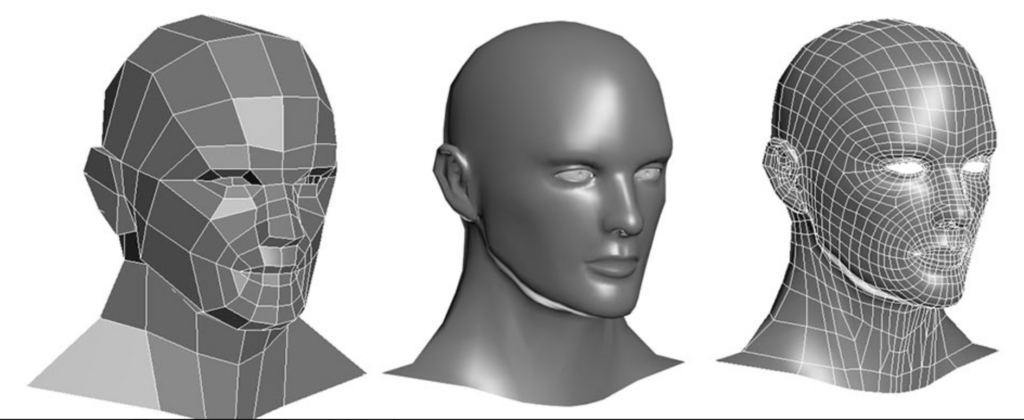
(Image from Ebal Studios)
⭐️ Where and for which use cases is Polygonal Modeling used?
Industries: Film, animation, video games.
Use cases: Creating detailed and complex models for films, animations, and games.
Model types: Characters, props, vehicles, environment elements.
👍 Pros of using Polygonal Modeling:
Allows for great control over details, widely used and supported by most 3D software, good for creating both organic and hard-surface models.
👎 Cons of using Polygonal Modeling:
Can be time-consuming, requires good understanding of topology, not ideal for creating smooth, curved surfaces.
🧰 Some of the popular tools used for Polygonal Modeling:
- Autodesk Maya
- Autodesk 3ds Max
- Blender
- Modo
NURBS or Curve Modeling
NURBS (Non-Uniform Rational B-Splines) or curve modeling uses curves and surfaces defined by mathematical functions. This method is often used in automotive and industrial design.
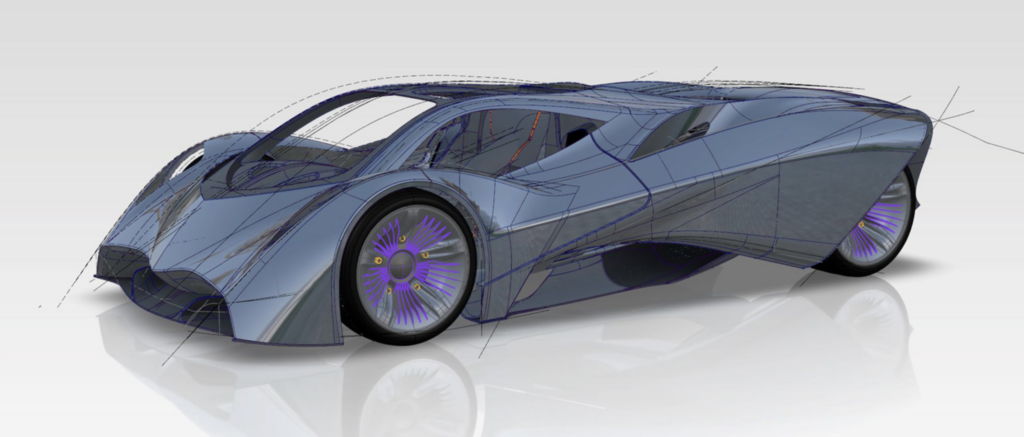
(Image from Vform Design)
⭐️ Where and for which use cases is NURBS/Curve modeling used?
Industries: Automotive design, industrial design, product design.
Use cases: Creating smooth, precise, and complex surfaces for products and vehicles.
Model types: Cars, boats, aircraft, consumer products.
👍 Pros of using NURBS/Curve Modeling:
Ideal for creating smooth, precise, and complex surfaces, widely used in industrial design, allows for easy modifications.
👎 Cons of using NURBS/Curve Modeling:
Less intuitive than polygonal modeling, not ideal for creating complex organic shapes, requires mathematical understanding.
🧰 Some of the popular tools used for NURBS/Curve modeling:
Sculpting
Digital sculpting is a more artistic method where the 3D modeler “sculpts” the 3D model in a way that’s similar to sculpting play-dough in the real world.
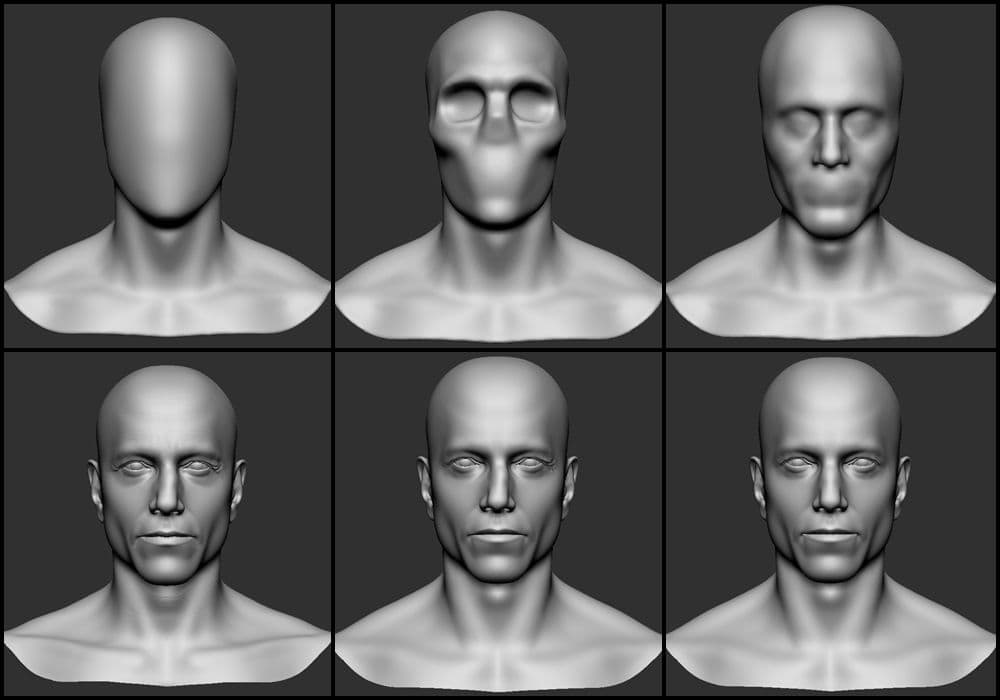
(Image from The Rookies)
⭐️ Where and for which use cases is 3D Sculpting used?
Industries: Film, video games, toy design.
Use cases: Creating highly detailed characters and creatures for films and games, designing toys.
Model types: Characters, creatures, organic forms, high-detail props.
👍 Pros of using 3D Sculpting:
Allows for high levels of detail, intuitive for artists with traditional sculpting background, ideal for creating organic shapes.
👎 Cons of using 3D Sculpting:
Requires powerful hardware for high-resolution models, not ideal for creating precise, hard-surface models, often requires retopology for animation or game use.
🧰 Some of the popular tools used for 3D Sculpting:
CAD Modeling
CAD (Computer-Aided Design) modeling is often used in engineering and industrial design. It involves creating precise, mathematical models, often using features like extrusions, revolutions, sweeps, and lofts.
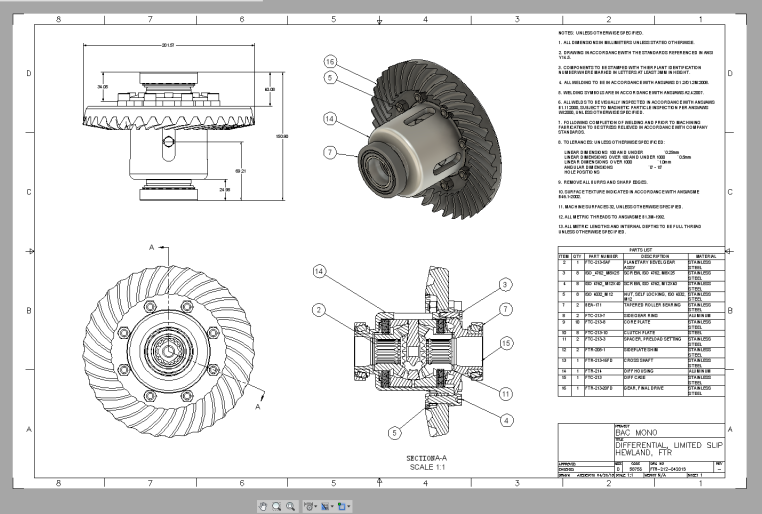
(Image from Autodesk)
⭐️ Where and for which use cases is CAD used?
- Industries: Engineering, architecture, industrial design.
- Use cases: Designing and prototyping products, creating architectural models, designing mechanical parts.
- Model types: Mechanical parts, architectural models, product designs.
👍 Pros of using CAD:
Ideal for creating precise, mathematical models, widely used in engineering and architecture, allows for parametric design.
👎 Cons of using CAD:
Steep learning curve, not ideal for creating organic shapes, requires understanding of engineering principles.
🧰 Some of the popular tools used for CAD:
Procedural Modeling
This method uses algorithms and mathematical functions to automatically create 3D models. It’s often used for creating complex scenes like landscapes or cityscapes.
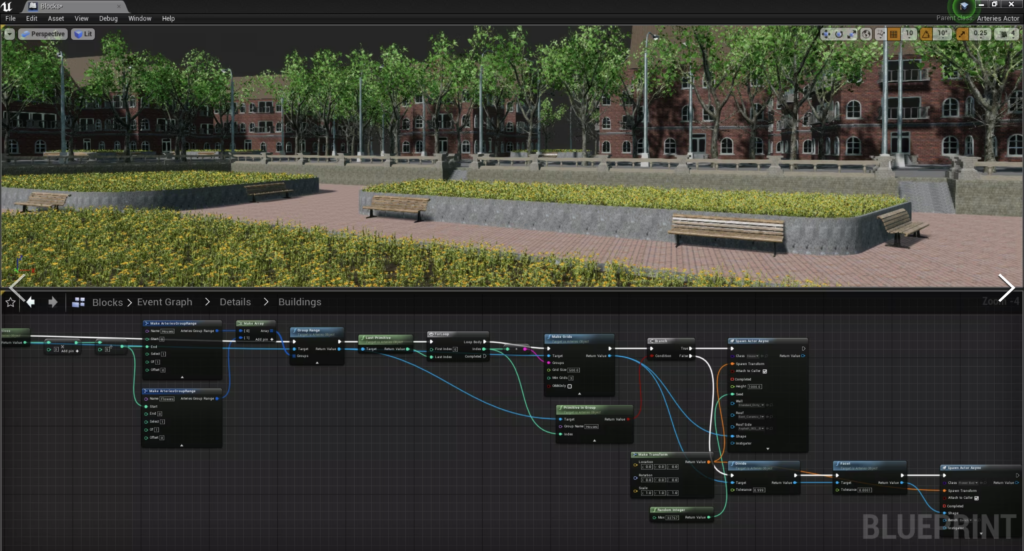
(Image from Unreal Engine)
⭐️ Where and for which use cases is Procedural Modeling used for?
Industries: Film, video games, visual effects.
Use cases: Creating complex scenes like landscapes or cityscapes, generating large amounts of content quickly.
Model types: Landscapes, cityscapes, fractal geometry, complex patterns.
👍 Pros of using Procedural Modeling:
Allows for creating complex models or scenes quickly, ideal for creating large amounts of content, allows for non-destructive workflows.
👎 Cons of using Procedural Modeling:
Requires understanding of algorithms and mathematical functions, less control over individual details, can be computationally intensive.
🧰 Some of the popular tools used for Procedural Modeling:
- Houdini
- Blender’s geometry nodes
Image-Based Modeling
This technique uses 2D images or photographs to create 3D models. It often involves techniques like photogrammetry, where multiple overlapping photographs are taken of the object or scene and in order to create a panorama and stitch it together into a 3D model of an object or surface.
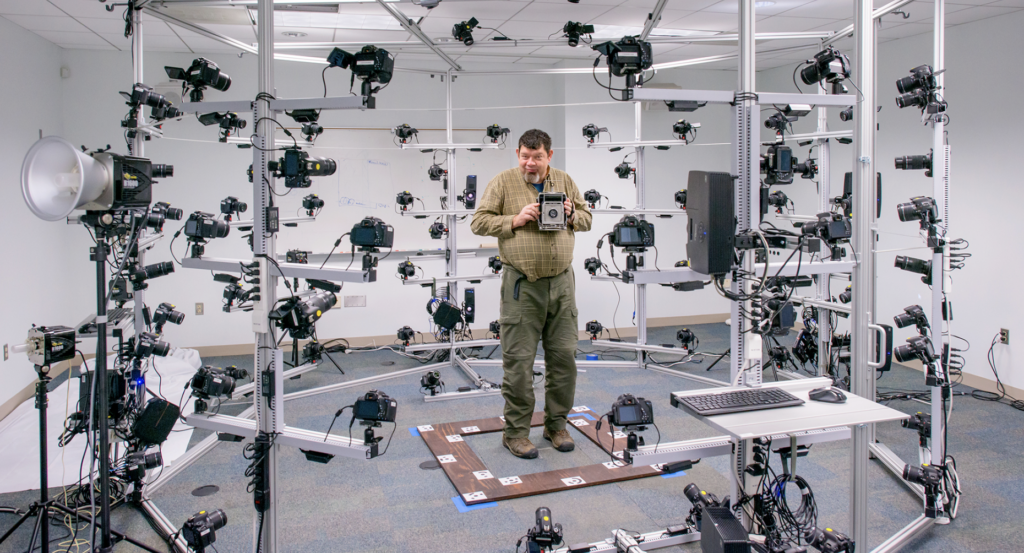
(Image from UMBC)
⭐️ Where and for which use cases is Image-Based Modeling used for?
Industries: Archaeology, architecture, film, video games.
Use cases: Creating 3D models from photographs, digitizing real-world objects and locations.
Model types: Buildings, terrain, real-world objects.
👍 Pros of using Image-Based Modeling:
Allows for creating 3D models from photographs, ideal for digitizing real-world objects and locations, can produce highly realistic results.
👎 Cons of using Image-Based Modeling:
Requires high-quality source images, can be time-consuming, results can vary based on lighting and quality of source images.
🧰 Some of the popular tools used for Image-Based modeling:
Retopology
This is a method often used in conjunction with digital sculpting. After a high-resolution model is sculpted, it’s often necessary to create a lower-resolution version for practical use. This process of creating a new, optimized mesh is called retopology.
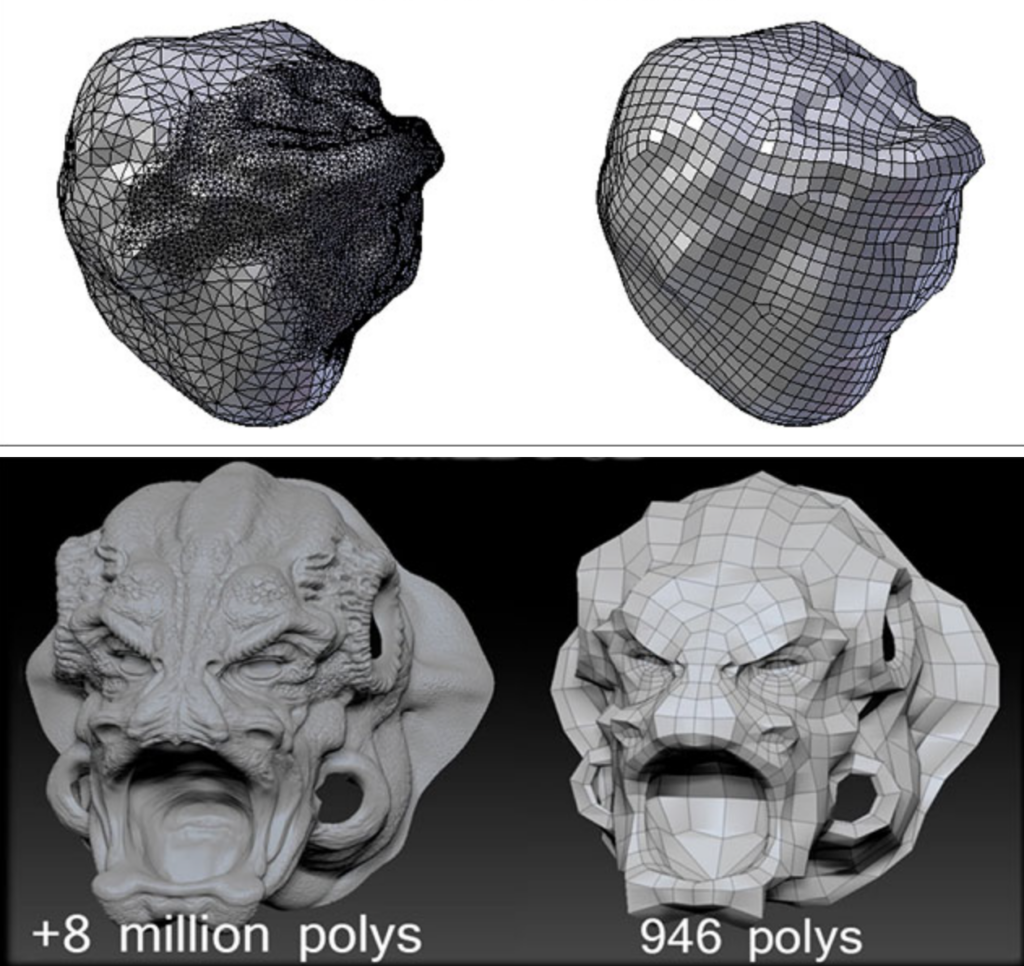
(Image from WKU)
⭐️ Where and for which use cases is Retopology used for?
Industries: Film, video games, animation.
Use cases: Optimizing high-resolution models for animation or game engines, cleaning up scanned or sculpted models.
Model types: Optimized versions of characters, creatures, props, and other models.
👍 Pros of using Retopology:
Allows for optimizing high-resolution models for animation or game use, can improve the deformations of a model, essential for professional workflows.
👎 Cons of using Retopology:
Can be time-consuming, requires understanding of good topology, can be a repetitive process.
🧰 Some of the popular tools used Retopology:
- TopoGun
- Blender’s retopology tools
- ZBrush’s ZRemesher
Innovation in 3D modeling is largely driven by the common struggles of traditional methods
Although, traditional methods provide extremely high-quality results for their respective use cases, you might have notices a few common denominators there, when it comes to the downside. Most of these methods:
❌ Have a steep learning curve and are not accessible to everyone: Each method has its own unique techniques and principles that need to be learned, and mastering a 3D modeling software can take a significant amount of time and practice.
❌ Are time-consuming: Many of these methods can be quite time-consuming, especially when creating detailed or complex models. This includes the process of creating the mesh model itself, as well as refining and optimizing it.
❌ Have hardware requirements: Several of these methods, especially those that involve creating high-resolution models or complex scenes, can be resource-intensive and require powerful hardware to run effectively.
❌ Balance of artistic and technical skills: 3D modeling often requires a balance of artistic and technical skills. Artists need to understand the principles of form, shape, and proportion, but also need to master the technical aspects of 3D software.
❌ Have limitations: Each method has its own limitations and is better suited to certain types of models or tasks. For example, some methods are better for creating organic shapes, while others are better for hard-surface models.
❌ Need multiple methods to be mixed: Often, a single method is not sufficient to create a model or a scene, and artists need to use a combination of methods. This requires learning and mastering multiple techniques and tools.
With that being said, I’d like to introduce a rather disruptive method of generating 3D models – a method that is aiming to tackle these challenges – to the equation:
Generative AI-powered 3D model creation
Compared to the 8 traditional methods listed above, AI-powered 3D model generation is a fairly new player to this field. However, it’s developing and improving extremely fast, and is definitely something for professionals working with and producing 3D models to keep an eye out for.
It has to be noted, the quality of AI-produced 3D models cannot compete with manual methods today, although it’s quickly moving in that direction. And although it can make the workflow of creating 3D models a lot faster today, it still needs post-production touch ups from a 3D artist.
❗️Please note, in this part of the article, specifically when talking about pros, cons and use cases, we’re also considering the potential of this technology.
The future of 3D model generation looks like an exciting time to be alive. Let’s take a look at the AI-powered 3D model generation landscape today!
AI in 3D modeling
Based on the input needed from the end-user, AI-powered 3D model generation can be categorised into 3 subcategories:
Text-to-3D: This method uses Natural Language Processing (NLP) to convert textual descriptions into 3D models. AI algorithms interpret the text and generate a corresponding 3D model automatically in the background. This method is particularly useful for quickly prototyping designs or for users who may not have extensive 3D modeling skills.
Image-to-3D: This method uses AI to convert 2D images into 3D models. The AI analyzes the image and uses depth perception and object recognition to create a 3D model. This method is useful for digitizing real-world objects or creating 3D assets from 2D concept art.
Video-to-3D: This method uses AI to convert video footage into 3D models or environments. The AI analyzes the video, tracking the movement of objects and people to create a 3D representation. This method is particularly useful for motion capture and creating 3D environments from real-world footage.
Benefits and limitations of AI-powered 3D content generation
With the 3D model output and experience for the end-user being largely similar with all 3 aforementioned AI-powered methods – the only difference from the user’s perspective being the input format – I’ll go through the pros and cons of Generative AI-powered 3D model creation method as a whole:
👍 Pros of using AI-powered 3D content generation:
Faster: AI can generate 3D models much faster than manual methods.
Cheaper: It can be up to 100 times cheaper per model compared to traditional 3D creation methods.
Accessibility/no expertise needed (potential): The process is simple and user-friendly, and doesn’t require 3D modeling expertise or a team of 3D designers. To note, we marked this as a potential pro, as many of the AI-powered 3D model creation tools are not accessible to the everyday user, with limited or no coding and/or 3D modeling experience. However, at Alpha3D, we have released a demo category (shoes) to the public, that you can go and play around with for free today using either text prompts or single shot 2D images.
Scalable: AI can generate 3D models at scale, making it ideal for large projects or for businesses that need to create a large number of 3D models.
Unlocking creativity: AI, specifically natural language to 3D, has the potential to unlock novel ways of adding the extra sprinkle to visualizing and shaping the world around us. These tools have the potential to help remove the repetitive manual tasks of 3D content creation, enabling 3D designers to fully focus on the creative part of the process.
👎 Cons of AI-powered 3D content generation:
Limited control: While AI can generate 3D models automatically, it may not offer the same level of control over manipulating the details of the model as manual methods.
Quality: As previously mentioned, the quality of AI-generated 3D models can’t compete with traditional methods today. Additionally, hallucinations may occur at times.
New technology: As a relatively new technology, there may be limitations and challenges that are not present in more established, traditional methods.
⭐️ Where and for which use cases can AI generated 3D models be used for?
Industries: Retail, e-commerce, gaming, VR/AR, film, and animation.
Use cases: Creating 3D product models for online retail and e-commerce (for example VTO), creating 3D assets for games and virtual reality experiences, digitizing real-world objects for use in films and animations.
Final thoughts
In conclusion, it’s safe to say the landscape of 3D modeling is undergoing a significant transformation. While traditional methods, ranging from box modeling to retopology, have served us well and continue to be vital in certain applications, the advent of AI-generated 3D modeling is undeniably reshaping the field.
AI-generated 3D model creation methods, are democratizing 3D modeling, making it faster, more cost-effective, and accessible to a wider audience.
As we continue to explore the capabilities of AI in 3D modeling, we can anticipate a future where the creation of 3D models becomes even more intuitive and efficient.
However, it’s important to remember that each method has its own strengths and applications, and the choice between traditional and AI-generated methods will depend on the specific needs and constraints of the project at hand.






